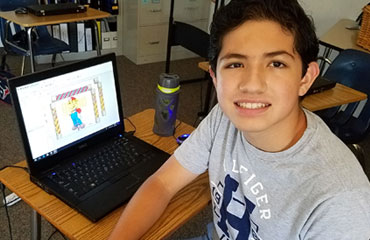Students develop polished 2D digital games that offer well-crafted narratives within a skillfully conceived technical framework.
Students review fundamental skills of digital design during the pre-production process of a 2D video game, focusing on creating a coherent look, feel, and narrative flow. Students develop custom backgrounds and sprite sheets, and select background music and sound effects that align with the feel of their game. Students program game events including collision detection, win/lose conditions, score monitors, and hit counters, which trigger physics reactions and game logic responses that advance the game. Students will integrate proper logic and coding strategies throughout, so that game events execute smoothly. Students apply their skills to the production of targeted assignments, including endless runner and platformer games. They will conclude the class by working independently to conceptualize a novel game, beta-test their product, and refine and ultimately present a polished, working game by the end of the course.



